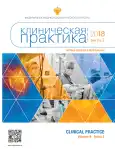Patterns of activation of vanilloid and purinergic receptors of the bladder urothelium in elderly with hyperfunction of urothelium, atherosclerosis and their combination
- Authors: Prashchaev K.I.1, Ilnitski A.N.1, Pranovich A.A.2, Gurko G.I.1, Selivanov A.N.2
-
Affiliations:
- Institute of Advanced Training of the FMBA of Russia
- Autonomous scientific non-profit organization of higher education of the research center «St. Petersburg Instituteof Bioregulation and gerontology»
- Issue: Vol 9, No 2 (2018)
- Pages: 30-35
- Section: Original Study Articles
- URL: https://journals.rcsi.science/clinpractice/article/view/10624
- DOI: https://doi.org/10.17816/clinpract09230-35
- ID: 10624
Cite item
Full Text
Abstract
This article describes the patterns of activation of vanilloid and purinergic receptors in the bladder tissue in males of different ages. Based on the obtained data, the conclusions are made about the prospects of using activation of these receptors as predictors of certain diseases of the male urinary tract, such as idiopathic increased activity of the bladder (overactive bladder) and as biological markers for evaluating the effectiveness of treatment in the combination of idiopathic overactive bladder and atherosclerotic changes of general nature.
Full Text
##article.viewOnOriginalSite##About the authors
K. I. Prashchaev
Institute of Advanced Training of the FMBA of Russia
Author for correspondence.
Email: prashchayeu@yandex.ru
профессор кафедры терапии, гериатрии и антивозрастной медицины
Russian Federation, MoscowA. N. Ilnitski
Institute of Advanced Training of the FMBA of Russia
Email: a-ilnitski@yandex.ru
заведующий кафедрой терапии, гериатрии и антивозрастной медицины
Russian Federation, MoscowA. A. Pranovich
Autonomous scientific non-profit organization of higher education of the research center «St. Petersburg Institute of Bioregulation and gerontology»
Email: e.pranovicch@yandex.ru
научный сотрудник
Russian Federation, St. PetersburgG. I. Gurko
Institute of Advanced Training of the FMBA of Russia
Email: gurko@yandex.ru
научный сотрудник
Russian Federation, MoscowA. N. Selivanov
Autonomous scientific non-profit organization of higher education of the research center «St. Petersburg Institute of Bioregulation and gerontology»
Email: selivanov789@mail.ru
научный сотрудник
Russian Federation, St. PetersburgReferences
- Аллазов С.А., Кодиров С.К., Дарханов Ж.А. и др. Гиперактивный мочевой пузырь у больных с доброкачественной гиперплазией (аденомой) предстательной железы // Академический журнал Западной Сибири. 2014. № 3 (52). С. 37–38.
- Veit-Rubin N., Meyer S., Achtari C. Overactive bladder syndrome-a public health challenge // Rev Med Suisse. 2016. No. 11. P. 492–495.
- Бердичевский В.Б. Гиперактивный мочевой пузырь // Медицинская наука и образование Урала. 2015. № 2-1 (82). С. 146–149.
- Martín A., Domercq M., Matute C. Inflammation in bladder: The role of cholinergic, purinergic and glutamatergic signaling // Ther Adv Neurol Disord. 2018. No. 4. P. 11–17.
- Salazar B.H., Hoffman K.A., Zhang C.I. et al. Electrical activity of the bladder is attenuated by intravesical inhibition of P2X2/3 receptors during micturition in female rats // Int Neurourol J. 2017. Vol. 21. No. 4. P. 259–264.
- Gormley E.A., Lightner D.J., Faraday M., Vasavada S.P. Diagnosis and treatment of overactive bladder (non-neurogenic) in adults: AUA/SUFU Guideline Amendment // The Journal of Urology. 2015. Vol. 193. No. 5. P. 1572–1580.
- Grundy L., Daly D.M., Chapple C. et al. TRPV1 enhances the afferent response to P2X receptor activation in the mouse urinary bladder // Sci Rep. 2018. No. 8 (1). P. 197.
- Cao H.L., Liu Z.J., Chang Z. Cordycepin induces apoptosis in human bladder cancer cells via activation of A3 adenosine receptors // Tumour Biol. 2017. No. 6. P. 28–33.
- Kamei J., Ito H., Aizawa N. et al. Age-related changes in function and gene expression of the male and female mouse bladder // Sci Rep. 2018. No. 8 (1). P. 2089.
Supplementary files






